Note as of November 17, 2013: I have reviewed this post to correct typos, improve wording, and add headings. I have highlighted substantial changes and additions.
Note as of May 23, 2014: I have added links to reviews of the study.
Note as of October 8, 2025: I have finally added images of pages of the report.
The “Bicyclists’ Injuries and the Cycling Environment” (BICE) study — of crash and comparison sites on the routes taken by 690 out of the 2335 cyclists treated in the emergency departments of five downtown hospitals in Toronto or Vancouver, May 18 2008 to November 30 2009 — is held by some as conclusive proof of the safety advantage of “cycle tracks” (segregated bikeways in the street corridor). However, it has been extensively criticized by others.
A report from this study is published in the journal Injury Prevention: Harris MA, Reynolds CCO, Winters M, Cripton PA, Shen H, Chipman ML, et al. Comparing the effects of infrastructure on bicycling injury at intersections and non-intersections using a case-crossover design. Inj Prev 2013;19:303-310. doi:10.1136/injuryprev-2012-040561. The report also is online.
Several criticisms have addressed the content of the report itself. These include two by M. Kary, posted in this blog. One of them appeared in edited form in the journal which published the article. Paul Schimek has prepared a presentation addressing the claims in the study. (To view the speaker notes, open it in Google Sheets, or download it and open it in a compatible application such as PowerPoint.)Schimek has also stated:
The City of Vancouver published a bicycle safety report in 2015, which
says on p. 49:
“It is important to note that the only protected bicycle lanes that
were included in the BICE study were the Carrall Street Greenway,
Burrard Bridge, and small segments of protected bicycle facilities
along Great Northern Way/Grandview Highway, Beach Avenue, and Stanley
Park Drive. The criteria set by the BICE study for classification as a
protected bicycle lane were that the facility must be: exactly
parallel to the road, within 3 metres of the road, and physically
separated from motor vehicle traffic and from any sidewalk.”
https://vancouver.ca/files/cov/cycling-safety-study-final-report.pdf
This confirms what I said about the study: they had no data on
protected bike lanes in Toronto, and only a tiny bit in Vancouver, but
mixed in with a larger number of ordinary bike paths not along city
streets.
I side with the critics. The results of the BICE study are wildly out of line with those of other research, by a factor ranging of as much as 2000%. The large 2007 Copenhagen study found streets with bike lanes and cycle tracks to have a significantly higher bicycle crash rate than the same streets before the special treatments were installed, and even the Lusk et al Montreal study, despite clear bias in route comparisons and statistical errors (see review here), found cycle tracks to be only 28% safer than comparison streets.
Epidemiology smears largely undifferentiated factors into an overall risk, obscuring rather than clarifying what makes for safety. Epidemiologists think of correlation, rather than of mechanisms. Epidemiologists can tell you where crash hotspots are but have very little to say about crash causation and prevention. In the medical field, this is counterbalanced by medical research and clinical practice. Disease prevention through hygienic practices, immunization, and avoidance of risky behaviors is well-understood. In bicycling, there is no such counterbalance, because of a disconnect between epidemiology and the scientific study of crash causation and prevention. This problem is exacerbated by the controversy over whether bicycling advocacy should be based on educating cyclists how to operate safely as individuals, or whether it should place the promotion of increased bicycle use above all other goals — an approach which appeals to public health advocates — including epidemiologists, in their medical milieu, who stress the health benefits of exercise and point out that they outweigh the crash risks. Skills and behaviors which prevent crashes are ignored, as long as the overall health of the population is seen as acceptable.
General comments about the Toronto-Vancouver study
I myself haven’t reviewed the study itself in depth, but I have published two detailed reviews of it:
M. Kary’s first comment letter about Harris et al., unedited
M. Kary’s second comment letter about Harris et al., unedited
The edited version of these replies is available online [now in the Internet Archive].
The results of the Toronto-Vancouver study are internally inconsistent, and wildly inconsistent with the results of other studies — see comments in those reviews and below.
I have, however, had a good long look at the PDF of the authors’ presentation at the 2012 Velo City conference. I would like to review a transcript or summary of the discussion which accompanied this screen presentation, but I have not found any to review, and so I’ll just go with the PDF. It provides ample fodder for commentary.
The photos often show facilities with obvious built-in hazards as examples of good design, and show examples of installations with no evident problems as examples of hazardous conditions (e.g., a neighborhood traffic circle on a quiet street shown as an illustration of the stunningly high crash rate which the study found for traffic circles).
One photo is used as an example of a low-risk facility and again as an example of a hazard.
Other commenters have noted that the study does not address cyclist behavior. It also suggests as one of its main conclusions that cyclists should ride more slowly downhill, not what I would call a practical suggestion. Photos in the PDF indiscriminately show good and poor cyclist behavior — more often poor behavior.
Comments on specific pages of the PDF. Click on the images to enlarge them.

p. 2 — I don’t know of any reliable source for bicycle use data in the USA. Concerning an attempt to generate it, see this: http://bikexprt.com/research/cpsc/index.htm. That report actually contains two sets of data and if you compare them, cyclists’ average speed is 1 1/4 mph. — and the author of the report didn’t catch this!

p. 4 Citation of safety in numbers depicts Jacobsen’s descending hyperbolic curve, and describes it as best evidence, though it has repeatedly been demolished as only an artifact of faulty math. See for example the posts and comments here:
https://john-s-allen.com/blog/?p=669
https://john-s-allen.com/blog/?p=1621
Also, the photo on this page (likely from Copenhagen, judging by the blue paint) shows a cyclist carrying a handbag on the handlebar, hazardous because it interferes with control of the bicycle and can get caught in the spokes.

p. 5 — the “vehicular cycling” photo shows a cyclist riding in the door zone. Also, it is no fault of the cyclists, but the street has trolley tracks, which regularly dump cyclists. We had a cyclist die in Boston when his wheels got caught in trolley tracks and he fell under a bus.

p. 12 — Shows a photo of a narrow two-way sidepath where cyclists would be blinded by oncoming motor vehicle headlamps at night and, if the cyclists stray or are forced into the street, they are trapped in the face of the oncoming traffic and cannot get back up over a curb. On the side away from the street, they will be toppled if they stray into the curb. The paved width of the path is marginal and there is no recovery if a cyclist strays off either side. This portrayed as an example of a safe facility. The authors have said that in Vancouver there were no wrong-way cycle tracks. Where is this? Update: See comments on this post. The sidepath in the photo is in Ottawa.
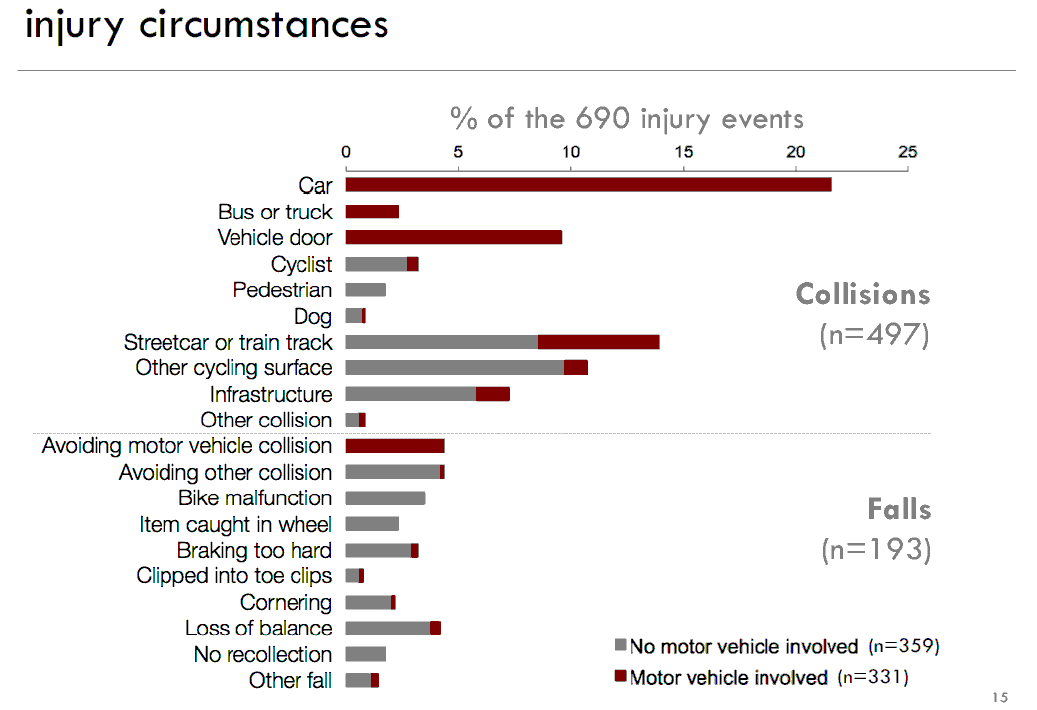
p. 15 — Falls due to streetcar or train tracks and other cycling surfaces, or “infrastructure” (What does that mean in this context?) are called collisions. They are not collisions, they are falls. Compare the distinction between a pedestrian’s trip-and-fall incident and a collision between a pedestrian and a vehicle. Describing falls as collisions skews the results, making it look as though falls are less important, and collisions (with a vehicle, bicycle or pedestrian), more so.

p. 16 — repeats the same photo of the two-way cycle track.

p. 17 — repeats the “vehicular cycling” photo.
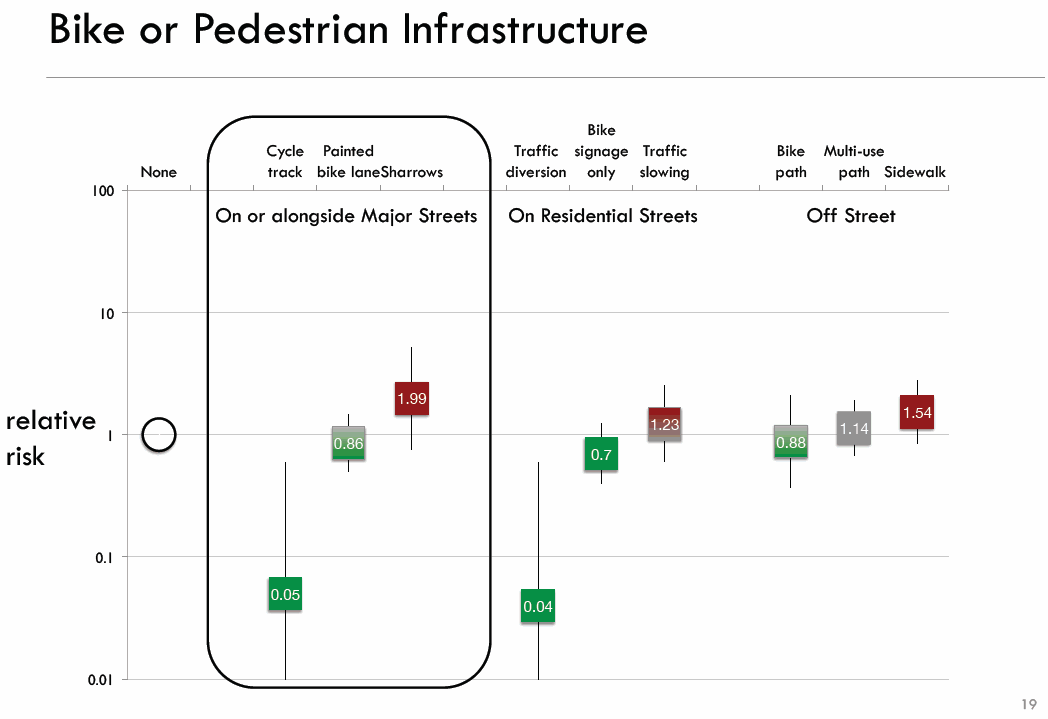
p. 19 — the level of relative risk for cycle tracks and “traffic diversion” streets (bicycle boulevards) is unbelievable. Note that the vertical scale of the garph is logarithmic. On page 15, we see that nearly half the reported crashes do not involve a motor vehicle. What would then make streets with cycle tracks 2000% and traffic-diversion streets 2500% safer than other streets?

p. 20 — Photos show the only two so-called cycle tracks in the study. Both are distinguished by their lack of cross streets and driveways. Hence, no car-bike collisions! This page makes the claim of 1/20 risk (2000% improvement) for cycle tracks, based on these data and in association with a photo of the separate path on the Burrard Bridge in Vancouver (upper left photo). The upper-middle bike lane photo shows a bike lane in the door zone. The upper-right shared-lane marking photo shows an improperly placed shared-lane marking, in the door zone. The authors do not make such distinctions when comparing crash locations. The authors have recorded intersections and non-intersection locations separately, and so they do not record the effect of design between intersections on the route which cyclists take when entering intersections and so, on crash rates at intersections.

p. 22 — traffic diversion v. traffic slowing — again, defies explanation. The upper left photo shows a cyclist turning past high vegetation which would produce a sight-line obstruction for a slightly shorter cyclist. The lower left photo shows wrong-side parking, which can result in motorists exiting parking spaces unable to see approaching cyclists, see http://www.bikexprt.com/bikepol/facil/lanes/contraflow.htm#scottst. The lower right photo shows a door-zone bike lane, but apparently what the photo is intended to show is the bulbout in the foreground, which would result in a “coffin corner” situation unless right turns are prohibited — note left-turn arrow in background — this is just before an intersection. But also, traffic slowing and traffic diversion are linked techniques, both used together in bicycle-boulevard treatments. How can they be separated for research purposes?

p. 24 — Left middle photo shows cyclists on a path headed for a low curb on a parapet high over a body of water. A path meeting reasonable design standards would have, instead of a curb which would topple bicycles, a railing to keep cyclists from going over the edge into the water. Left lower photo shows sharp curves leading to bollards on a bike path. Bollards are a well-known hazard. Yet the study claims greater safety for these than “no infrastructure” (which means, actually, different infrastructure). This same photo is shown again on page 50 as an example of the hazard of bollards. Lower middle photo is captioned as “shared-use path” but is a cramped situation in what appears to be an outdoor mall, nothing that would normally be designated as a shared-use path.
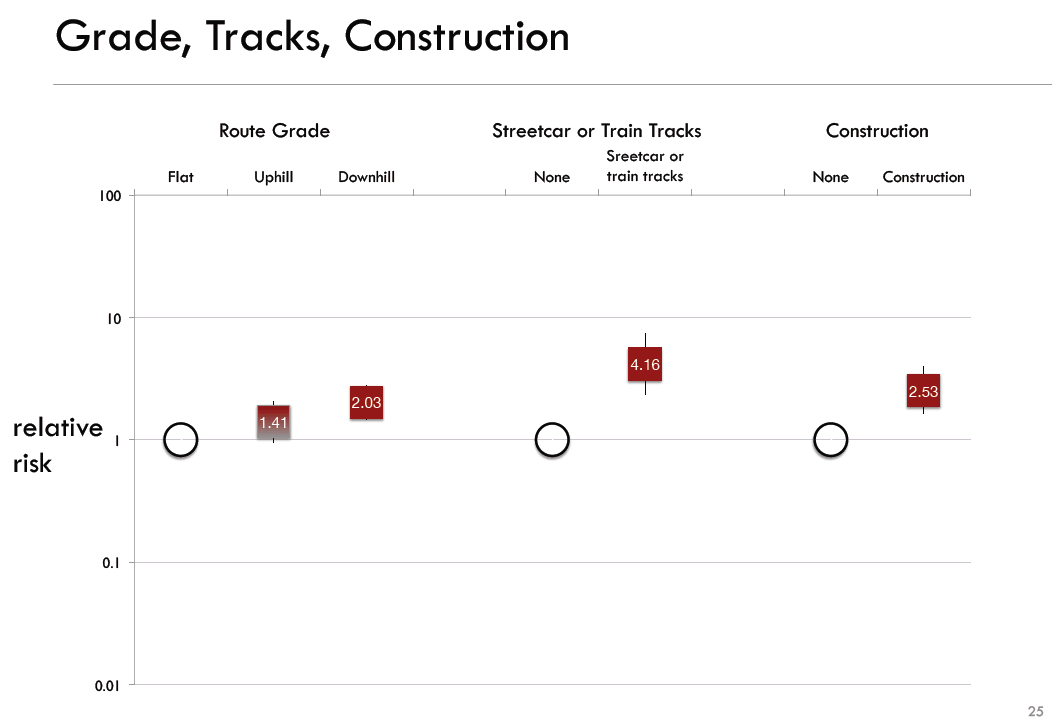
p. 25 — not very surprising except that uphill is rated hazardous. Why? The 1976 Bikecentennial study found a crash rate 4 times as high for cyclists going downhill, see http://www.bikexprt.com/research/bikecentennial/p35accident.htm.

p. 26 — upper left photo shows a cyclist riding downhill too close to parked vehicles. Upper right photo appears to show a cyclist riding on or near the wrong side of a two-way street. Middle left photo shows a cyclist properly ignoring a poorly-placed shared-lane marking while riding downhill. Lower photo shows a hillcrest, car with brake lights on though it is climbing, no cyclist in the photo. Apparently, the claim of danger is due to limited sight distance at the top of the climb.

p. 29 — once again repeats the unbelievable results, which contradict those of numerous other studies. Also shows the hazardous two-way cycle track from page 12 again.

p. 31 shows a “bike box” except cyclists are entering from the sidewalk at right angles to the street. This is not what a “bike box” is usually intended for. Also, entering from the right immediately before an intersection has been shown very hazardous, because motorists look left for cross traffic. What is the point of this photo?
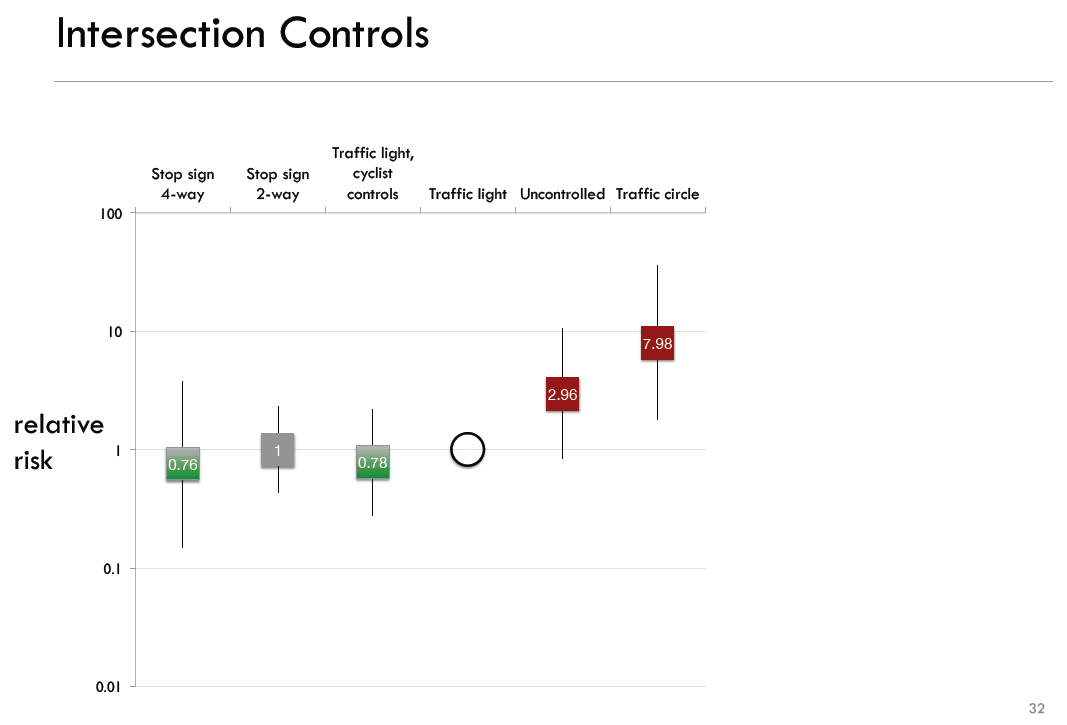
p. 32 — Why are traffic circles rated so hazardous? Do we distinguish traffic circles and roundabouts? Why are uncontrolled intersections so hazardous when most of them are between very lightly used streets? How do we account for cyclists’ obeying or disobeying signals?

p. 33 — photo shows a cyclist very far to the right when crossing an intersection, on the crosswalk line. This would require weaving to the right when entering the intersection and to the left, back into the stream of traffic, when leaving it.

p. 34 — shows an intersection where cyclists may enter by pushing a button. There is a narrow entry channel between curbs. There is a risk of striking a curb and crashing.

p. 35 — shows two cyclists waiting at a stop sign. Both are ahead of the legal stop line (though that may be needed in order to see cross traffic). One has her foot on the curb at the corner — this far-right position invites the “right hook”, and prevents others from legally turning right. A commenter on this post has pointed out that to push the button which actuates the signal, cyclists must be in the right-hook position. I can add that the cyclists also must be ahead of the stop line to push that button. to sum up: this installation requires behavior which is illegal as well as hazardous.

p. 36 — The traffic circle shown is a small neighborhood traffic circle on a street with slow, light traffic. What is the hazard then, which raises the reported crash rate for traffic circles so high?

p. 37 — claims greater safety at intersections for streets with separated bikeways. This contradicts the observation and results that such intersections have more conflicts and a higher crash rate, as shown in numerous other studies.

p. 38 — The results reflect the speed, type and volume of conflicting traffic and so do not describe how volume and speed affect risk, or accurately describe the risk which depends on the design of a facility. Cyclists are shown waiting for a traffic signal in the “coffin corner.”
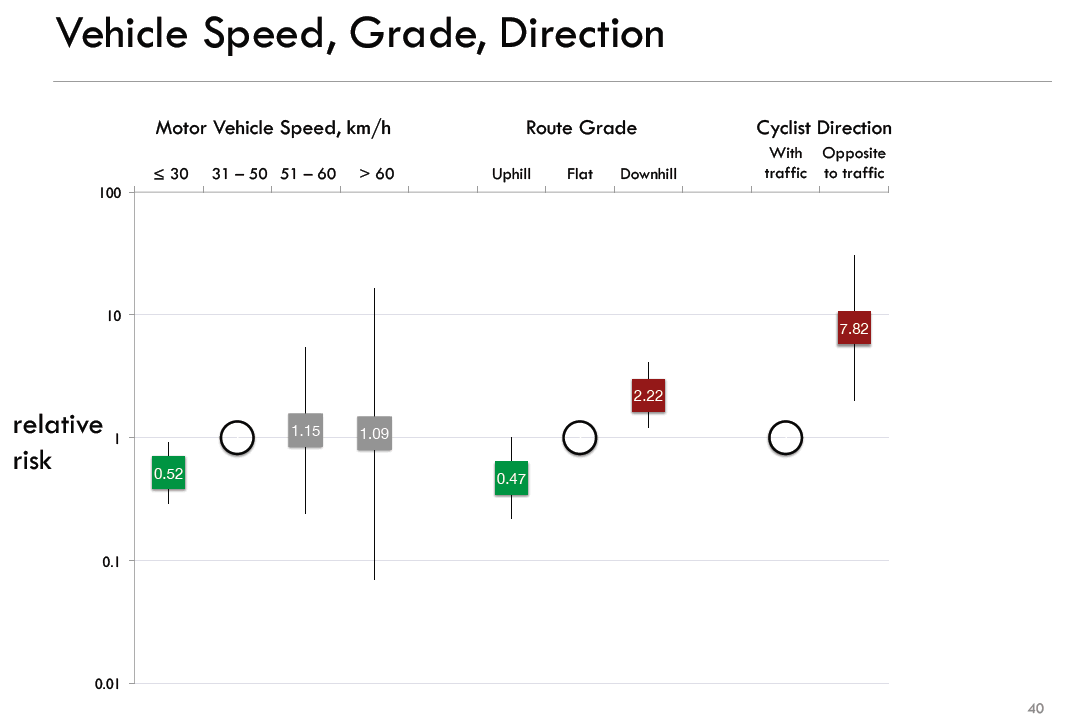
p. 40 — How is uphill less dangerous here and more dangerous earlier?

p. 41 — It is surprising that risk does not increase with motor vehicle speed above 30 km/h. Other studies show quite the opposite. What other factors counterbalance speed?

p. 42 — same photos of uphill cyclist on wrong side of road, and downhill cyclist ignoring the poorly placed SLM, as on p. 26.

P. 43 — From the picture, it is not possible to determine whether the cyclists are riding on the wrong side of a two-way street, or on the left side of a one-way street.
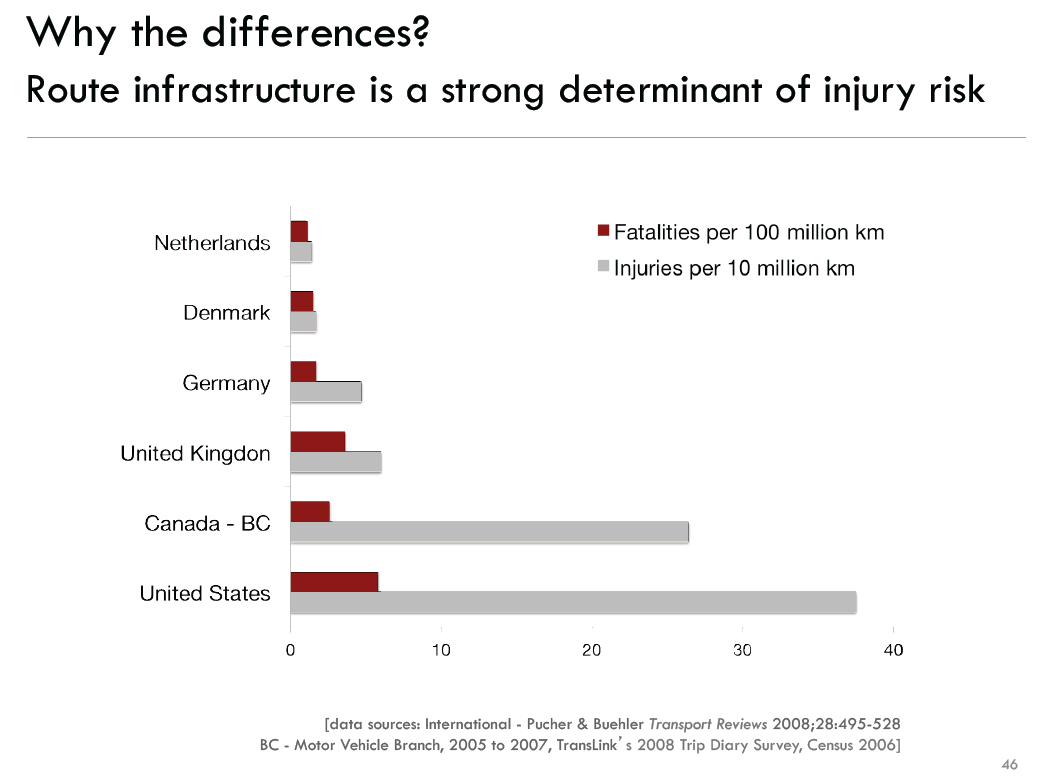
p. 46 — “Route infrastructure is a strong determinant of injury risks” — This is correlation, not causation. It compares entire countries with one another. Many other factors differ among the countries cited.

p. 47 — Shows a different photo of thesidepath also shown on page 12, where cyclists would be blinded by oncoming motor-vehicle headlamps at night and, if they stray or are forced into the street, are trapped in oncoming traffic and cannot get back up over a curb. On the side away from the street, they will be toppled if they stray into the curb. The width of the sidepath is marginal and there is no recovery if a cyclist strays off either side. This is portrayed as an example of a safe facility.

P. 48 — “Physical barrier between cyclists and traffic.” As mentioned earlier and shown in the photo, the facility used for comparison is no ordinary cycle track in that it lacks intersections and driveways, and so achieves a complete physical separation. Furthermore, the terminology is faulty. Cyclists cannot be removed from traffic unless they are removed from each other — because they are traffic.
The page also claims that previous research did not distinguish between cycle tracks, bike lanes etc. This is blatantly false — several important studies do. I am thinking in particular of Moritz’s 1990s studies and the 2007 Copenhagen study.

p. 49 — claim that reducing motor vehicle speeds is key does not comport with results shown in this study unless motor speed is below 30 km/h (19 mph). That is not the case with most arterial streets. Claim that reducing cyclist speed down hills would reduce crash rate agrees with other studies, but it must be asked: what are the speeds in question? Is a cyclist who is able to keep up with motor traffic thereby more endangered? What are the behaviors that make high cyclist speed more hazardous? How would the authors propose to reduce the speed of cyclists, who want to get where they are going in good time, and rarely can even reach the speed limit? Cyclists then suffer a disadvantage both uphill and downhill. As the study looked only into locations, not behavior, that question begs for an answer.

p. 50 — the same photo of a bicycle path with bollards, shown on page 24 as an example of a safer facility, is now shown as an example of obstacles which should be removed.

p. 51 — claim of objective measurement leaves out the elephant in the room — behavior.
Conclusion
As already mentioned, the numerical results are beyond credibility. It is also clear that the authors do not know what constitutes safe cycling behavior or what their photographs are showing.

I notice many of the names behind the study and the report are those of ‘the usual suspects’ – these are bicycle facility propagandists first, and while they supposedly have a scientific background, it appears to play little role in their activities. I find it impossible to credit such people as ‘researchers’ or the papers they write as ‘studies’ or ‘reports’. Papers like these show the inherent flaws in the system of peer review in some areas of academia.
The study cited to show that cyclists have higher risks (death and injury rate per 100 million person-trips is the statistic) than motor vehicle occupants is the Beck et al 2007 study (link below). But that study shows that males crank up the injury rate while women’s rates overlap with the motor vehicle statistics. I wonder if we just need to make cycling safer by giving male cyclists estrogen pills. Also wonder what activities males dominate (risk taking?) that make them bigger risks.
http://aje.oxfordjournals.org/content/166/2/212.full.pdf+html
The referenced article sounds like this article …
http://ajph.aphapublications.org/doi/pdf/10.2105/AJPH.2012.300762
… although the point estimates are different.
OK … I see. The difference is that intersections/non-intersections are separated out in the later paper.
Rather than the slides, here is the full paper.
http://injuryprevention.bmj.com/content/early/2013/02/13/injuryprev-2012-040561.full.html
John, do you really think that nitpicking about purses on handlebars in the slides from a paper is helping your cause? I started reading your list but refused to finish due to the irrelevant comments. You often make valid and salient points, and I understand these slides appear to attack you directly, but I don’t think anyone will be converted because of incidental details about cyclists’ behaviors in the pictures. Errors like treating a fall due to streetcar tracks as a collision is the kind of stuff that needs more prominence, but in your post is obscured by nitpicking.
If you filmed your videos in areas where there were a lot of cyclists, I’m sure some of the ones filmed in the background would be cycling dangerously. I doubt you’d appreciate it if others tried to attack vehicular cycling by pointing out an irrelevant thing like that in your videos!
Commenting on Jean-Francois’s criticism. What John may be getting at is that unsafe behavior by cyclists, such as balancing stuff on handlebars, contributes to higher crash rates than would otherwise be measured. I’ve avoided crashes (with cars as well as with animals and inanimate objects) with the use of nifty bicycle handling that would have been difficult if I was balancing stuff on my handlebars or had never learned an instant turn. So by focusing only on the infrastructure rather than on what the cyclist contributed to the crash, maybe we are missing something.
If one compares highly experienced cyclists to novice cyclists as has been done by past researchers, one would probably find the highly experienced cyclists make fewer mistakes leading to crashes and also are more astute observers of traffic, thus avoiding many crashes. If there is both a strength and a flaw in the VC model, its strength is that competent cycling can drastically reduce crash rates. The flaw is that few people consider they need to be competent bicyclists and they are encouraged to avoid competence through advocacy that asserts that engineering controls will make them safe. Only to a point will it make them safe but the European model would probably keep your average inept cyclist alive longer than current U.S. roads will.
I also worry about what happens to the statistics when one dumps crashes associated with streetcar tracks, etc., into “collisions”. How does one collide with a track or for that matter, with a cycling surface? These are more correctly diversion falls. Such gaffes point to problems with infrastructure to be sure (as well as training) but also to sloppy peer review and authorship.
I do think that if we want a model where everyone from 8 to 80 is riding bicycles with little or no training or expertise, then one has to put in strong engineering controls to prevent the more lethal kinds of crashes with moving motor vehicles due to inexperience, poor coordination, bad judgment, inclement conditions, etc. as well as motorist error. Having said that, we need to recall The Parable According to John of the Swimming Pool in the Town Down the Road–don’t do it half-assed. [See comments on another post for an explanation of the swimming-pool analogy — John Allen] Engineering controls may not reduce the incidents of falls, bike-bike crashes, or crashes with inanimate objects, and may not teach people good riding skills but if done right, would certainly minimize bike-MV crashes. But getting back to what I’ve harped on before, those European cities didn’t get high bicycling rates just by building bike facilities. They also put very heavy financial penalties on car-dependence. Until we do that in the States, we will be sub-optimal in our turnout. It is just too easy for people to drive, at least right now. Its a different model over there. Folks like Ian, John, and Yours Truly ride because we want to, not because the Government is prying us out of our cars.
By the way, close to 40% of those “collisions” would be excluded if one took out “collisions” with tracks, surfaces, or infrastructure. I also don’t know how one would eliminate crashes with other cyclists, (or pedestrians and dogs) with cycletracks. So what happens to the study if you chop out 40% of your incidents? Were these included to puff up the occurrences?
Seems to me whoever peer-reviewed this work missed a few things.
Correction, that “close to 40%” includes crashes with dogs, peds, and other bicyclists.
In terms of absolute safety, a highly skilled cyclist on a street with no bicycle-specific infrastructure is surely safer than a less skilled one in the same environment. The highly skilled cyclist is likely also safer than the less skilled one when using bicycle-specific infrastructure, although that environment may indeed be less safe overall for the highly skilled cyclist than the one without any bicycle-specific infrastructure. However, the bicycle specific infrastructure is likely safer for the less skilled cyclist than having no infrastructure, since there are some built-in protections that they gain despite their lack of education.
To me, the point of bicycle-specific infrastructure is to make it safer for the less skilled cyclists and to make it more pleasant so that more people feel comfortable bicycling. (Myself included. I feel confident that I can safely bicycle on just about any road, but it doesn’t mean I will enjoy it.) No matter how safe you tell people vehicular cycling can be if done properly, you’re never going to appeal to most of the population. I’ve been trying to convince many of my friends to bike, explaining to them that I’ve never been in a crash after riding in the city nearly every day for 8+ years. But they still continue to think I’m crazy and that they would not fare as well unless there were at least bike lanes along their entire route. Since more bike lanes have popped up, a few of them have started bicycling, while others are still afraid. Some will not bike at all unless they have a completely traffic-separated facility from door to door. Nothing I can say or do will convince them otherwise.
Charlie said: “To me, the point of bicycle-specific infrastructure is to make it safer for the less skilled cyclists and to make it more pleasant so that more people feel comfortable bicycling.”
That’s the problem. Much of the bicycle-specific stuff manufactures conflicts (especially at intersections) that make it *LESS SAFE* for less-skilled cyclists.
The problem with some of the intersection infrastructure is that it manufactures a conflict but does not mitigate it because mitigating a proliferation of conflicts means reduced level of service, usually for the cyclist but inevitably, for everybody.
Bicyclists and motorcyclists will always be at a disadvantage at intersections (sensu lato) because we are small vehicles and easy to overlook if one is a motorist looking for other cars. We try to counter this disadvantage with countermeasures like optimal lane positioning (which is defeated with separated infrastructure) and in the case of motorcycles, big headlights and arrays of running lights. Those mitigate but do not eliminate the basic problem.
Some of us are willing to accept those risks and countermeasures. Others prefer the relative safety of a car. I’ll defer discussions of specific cycling infrastructure to those who are actually using it, as the devils are always in the details.
FWIW, I concur with Jean-François’ criticism. Just based on my personal anecdotes while teaching, I found that sticking to a limited number of “big” ideas was far more fruitful than grinding out small points.
Of course, YMMV.
I am not addressing students in a class: I am attempting to reach anyone who is willing to look at the content of the presentation.
One photo is used to indicate what is described both as a safe situation and an unsafe situation. Several photos show unsafe riding practices and/or infrastructure design and describe them as safe — others, the opposite. Several types of falls are described as collisions. More than half of crashes reported don’t involve motor vehicles but there is also a claim of a 2000% improvement in safety on facilities without motor vehicles. None of the several other studies which have looked at similar issues have found anything remotely like that, but this presentation claims that no comparable studies exist. Meanwhile, this study is being touted as definitive — because it most confirms what some advocates want to hear. Yes, I had to make my case bit by bit, looking through the examples, but here’s the bottom line: whoever put this presentation together was at least careless and more likely clueless. That is nitpicking? No, it’s laying brick on brick and when you’re done you have a wall.
Here is another of Vancouver’s non-existent wrong-way bike lanes.
http://goo.gl/maps/1j32n
This bikeway was nonexistent as of the time the data was collected for the study. It wouldn’t be odd — as a contraflow bikeway — except that it is on the left side of the street, resulting in confusion and conflicts. Canada went over from left-side to right-side driving during the First World War, having realized that compatibility with the neighboring USA was more important than compatibility with the rest of the British Commonwealth, accessible only by sea!
Also check out what’s at the other end of the block. Craziness, dumping cyclists into an intersection on the left side of the street.
http://goo.gl/maps/St0E1
The cycle track pictures referenced on pages 12,16, and 47 are from Ottawa, Canada on the approach to the Alexandra Bridge and would likely have been planned and designed by the National Capital Commission. See the streetview here: http://goo.gl/maps/bDdfm
Re: Page 35, this picture shows a configuration that is common throughout the Vancouver cycling network and makes use of a traffic signal phasing that, to my knowledge, is unique to British Columbia. Note the pushbutton on the stop sign to the cyclist’s right. The main street traffic signal heads display a flashing green while side street traffic is controlled by a stop sign and pedestrians by the standard “red hand”. When the push button is activated the main street signal will, following a minimum flashing green time, go to amber and then red. The side street gets a “walk” phase, however, both cyclists and motor vehicles are still legally regulated by the stop sign. As you can imagine, in practice this configuration results in a lot of cyclists and motorists blowing through on the “walk” or “flashing don’t walk” phases. They function like a hybrid of a two-way stop and a cyclist-actuated signal, with the undesirable feature of having the cyclist pull into the right hook zone to press the button and trigger the signal change.
There are a couple of similar treatments in Portland, Oregon, USA. I have commented on one where the cross street has a HAWK beacon, in another post on this blog. As with the Vancouver installations, the Portland one requires cyclists to pull to the right into right-hook position to push the button. In my blog post, I made a couple of suggestions as to how to avoid this problem.
In Vancouver some (a few) of those intersections that used to have a push-button on the right side have been changed to have a bike-activated pressure sensor in the middle of the lane. These changes are mostly for the high bike-traffic routes. This one needs a better indication that it has a sensor, but it’s one I use often: http://goo.gl/maps/w5N1U
In some places the button is placed in the middle of a traffic diverter like here: http://goo.gl/maps/ebctB and here: http://goo.gl/maps/vT4TF
In Vancouver the button system is so ubiquitous that bike advocates are very happy when “button-free infrastructure” is installed. Imagine if we made motorists have to roll down their window and push a button to cross a street! Actually I’ve seen motorists get out of their cars to push the cyclist button when waiting to cross a busy street.
The push-button system is mostly used when it’s one of those “Neighborhood Bike Street” routes that crosses a major motor route. There is almost never a painted lane divider, and the streets are narrow enough that oncoming motorists often have to yield to each other to pass (they should do the same with cyclists but often don’t). This means that the placing of the button in the right-hook position isn’t as bad as in other examples, like painted bike lanes in the right-hook position on a major street coming up to an intersection.